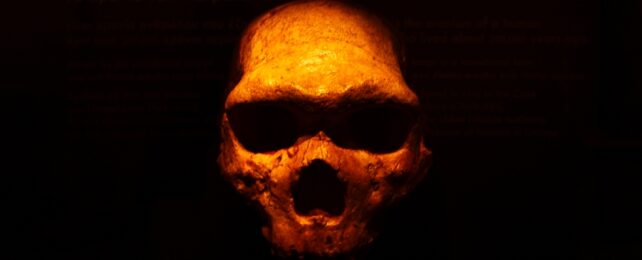As Homo sapiens migrated into Eurasia more than 70,000 years ago, much of the continent was already inhabited by Neanderthals, hominins who shared an ancestor with us but had spent roughly half a million years diverging.
We don't know much about their ensuing relationship, but it was probably contentious at times. While Neanderthals eventually disappeared 40,000 years ago, there are now 8 billion of us.
During their Late Pleistocene overlap in Eurasia, however, we know the two hominin species sometimes interbred, since many humans today still have traces of Neanderthal DNA.
And according to a new study, this relationship goes back even farther than we thought, with a long-forgotten earlier chapter re-emerging from clues in the Neanderthal genome.
When modern humans reached Eurasia in the Late Pleistocene, the study suggests, Neanderthals living there already carried traces of our species' DNA, apparently from a much older, previously unknown run-in with an even more ancient lineage of anatomically modern humans.
That would mean some Homo sapiens ventured into Eurasia more than 250,000 years ago, the study's authors report, long before the continent's earliest evidence of modern humans. For context, the fossil record indicates our species evolved in Africa only 300,000 years ago.
"We found this reflection of ancient interbreeding where genes flowed from ancient modern humans into Neanderthals," says Alexander Platt, an evolutionary biologist at the University of Pennsylvania.
"This group of individuals left Africa between 250,000 and 270,000 years ago. They were sort of the cousins to all humans alive today, and they were much more like us than Neanderthals," Platt says.
The early modern humans who made it to Eurasia later died out, the researchers note, and Neanderthals continued to dominate the continent for another 200,000 years or so. Hidden in the Neanderthal genome, however, were remnants from this ancient encounter.
To reveal this, the study's authors first followed clues uncovered by another recent study, which found Neanderthal-like chunks of DNA – called Neanderthal-homologous regions (NHRs) – in multiple present-day human populations from Africa.
This was surprising, since most interbreeding between modern humans and Neanderthals likely happened in Eurasia. It raised questions about how Neanderthal DNA, typically associated with Eurasian ancestry, could be seemingly abundant in Africa.
The actual prevalence of NHRs across Africa was still unclear, though. Previous research had relied on a limited set of genomes with a relatively recent common ancestry in West and Central Africa, note the authors of the new study.
To address that, they analyzed a wider range of modern genomes, representing 180 people from 12 genetically diverse populations in Botswana, Cameroon, Ethiopia, and Tanzania. Researchers compared these with a Neanderthal genome from an individual that lived in Russia's Altai Mountains about 120,000 years ago.
"This study highlights the importance of including ethnically and geographically diverse populations in human genetics and genomic studies," says senior author Sarah Tishkoff, a geneticist at the University of Pennsylvania.

Using a novel statistical technique, the researchers investigated when and how NHRs entered these populations. Did modern humans inherit genes from Neanderthals and bring them back to Africa? Or did our species give these genes to Neanderthals in the first place?
The answer is some of both, the researchers say, but mainly the latter.
NHRs were found in every population tested, showing they are widespread in Africa. Most of this 'Neanderthal-like' DNA originated not with Neanderthals, however, but with ancient modern humans who migrated from Africa to Eurasia about 250,000 years ago.
As the newcomers interbred with Neanderthals, they left a legacy: Up to 6 percent of the Neanderthal genome came from early members of our species, the researchers report.
The study also found evidence that, in certain populations, Neanderthal genes were introduced by people migrating back to Africa from Eurasia, where their ancestors had presumably interbred with Neanderthals.
Gene variants from Homo sapiens are mostly located in noncoding regions of the Neanderthal genome, the researchers point out, which suggests natural selection was weeding them out of the coding sections – possibly because our DNA wasn't helpful for Neanderthals.
Our own genome is also still gradually shedding gene variants from Neanderthals, they note.
"So a Neanderthal allele might work great in Neanderthals, but you plop it into a modern human genome and it causes problems. Both modern humans and Neanderthals slowly rid themselves of the alleles of the other group," Platt says.
Despite interbreeding "quite readily," Neanderthals and modern humans had evolved some significant differences during their roughly 500,000 years apart, and "we were very far along the path to becoming distinct species," Platt says.
The study was published in Current Biology.
